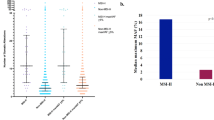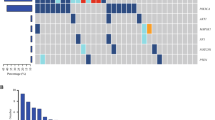Abstract
Background
Chromosomal instabilities (CIN) of plasma cell-free DNA (cfDNA) are common in breast cancer. We aimed to investigate the value of cfDNA CIN in monitoring the breast cancer relapse and additionally to compare it with the traditional biomarkers (CA15-3 and CEA).
Methods
Overall 62 recurrent breast cancer patients and 20 healthy controls were recruited. Low-pass whole-genome sequencing (LPWGS) was performed to detect cfDNA CIN. A CIN score was calculated. The performance of CA15-3, CEA, and CIN score in monitoring the recurrence was investigated with receiver operating characteristic (ROC) curve and the area under curve (AUC). Multivariable Cox proportional hazard model was established to analyze the correlations between copy number gain/loss and disease-free survival (DFS).
Results
cfDNA CIN achieved the positive rate of 77.6% [(95% confidence interval (CI) 73.4–95.3%)] among recurrent breast cancer patients, with an AUC value of 0.933, superior to CA15-3 (positive rate: 38.7%; AUC: 0.864) and CEA (positive rate: 41.93%; AUC: 0.878) (P < 0.01). The combination of cfDNA CIN with two biomarkers further increased the positive rate to 88.7% (95% confidence interval 77.5–95.0%). cfDNA CIN achieved better performance in patients with shorter DFS (≤ 41 months), with an AUC value of 0.975.
Conclusions
cfDNA CIN yields a higher accuracy in monitoring breast cancer recurrence compared to traditional biomarkers (CA15-3 and CEA), especially for biomarker-negative patients. The combination of cfDNA CIN to traditional biomarkers further improved the detection rate of recurrence, which may provide a new method for monitoring the early relapse of breast cancer, though further investigations are warranted.




Similar content being viewed by others
References
Bray F, Ferlay J, Soerjomataram I, Siegel RL, Torre LA, Jemal A (2018) Global cancer statistics 2018: GLOBOCAN estimates of incidence and mortality worldwide for 36 cancers in 185 countries. CA 68(6):394–424
Ferlay J, Soerjomataram I, Dikshit R, Eser S, Mathers C, Rebelo M, Parkin DM, Forman D, Bray F (2015) Cancer incidence and mortality worldwide: sources, methods and major patterns in GLOBOCAN 2012. Int J Cancer 136(5):E359–E386. https://doi.org/10.1002/ijc.29210
Lacey H, Judith H (2015) MUC1-mediated motility in breast cancer: a review highlighting the role of the MUC1/ICAM-1/Src signaling triad. Clin Exp Metastasis 32(4):393–403
Dawson SJ, Tsui DW, Murtaza M, Biggs H (2013) Analysis of circulating tumor DNA to monitor metastatic breast cancer. N Engl J Med 368(13):1199–1209
Guadagni F, Ferroni P, Carlini S, Mariotti S, Spila A, Aloe S, D’Alessandro R, Carone MD, Cicchetti A, Ricciotti A (2001) A re-evaluation of carcinoembryonic antigen (CEA) as a serum marker for breast cancer: a prospective longitudinal study. Clin Cancer Res 7(8):2357–2362
Aguiar-Bujanda D, Bohn-Sarmiento U, Aguiar-Morales J (2004) False elevation of serum CA 15-3 levels in patients under follow-up for breast cancer. Breast J 10(4):375–376
Gioia D, Di Stieber P, Schmidt GP, Nagel D, Heinemann V, Baur-Melnyk A (2015) Early detection of metastatic disease in asymptomatic breast cancer patients with whole-body imaging and defined tumour marker increase. Breast Dis 112(5):809–818
Newman AM, Bratman SV, To J, Wynne JF, Eclov NC, Modlin LA, Liu CL, Neal JW, Wakelee HA, Merritt RE, Shrager JB, Loo BW Jr (2014) An ultrasensitive method for quantitating circulating tumor DNA with broad patient coverage. Nat Med 20(5):548–554. https://doi.org/10.1038/nm.3519
Yarchoan M, Hopkins A, Jaffee EM (2017) Tumor mutational burden and response rate to PD-1 inhibition. N Engl J Med 377(25):2500
Network TCGA (2012) Comprehensive molecular portraits of human breast tumors. Nature 490(7418):61–70
Knouse KA, Davoli T, Elledge SJ, Amon A (2017) Aneuploidy in cancer: seq-ing answers to old questions. Annu Rev Cancer Biol 1(1):335–354
Goh JY, Feng M, Wang W, Oguz G, Smjm Y, Lee PL, Bao Y, Lim TH, Wang P, Tam WL (2017) Chromosome 1q21.3 amplification is a trackable biomarker and actionable target for breast cancer recurrence. Nat Med 23(11):1319
Stover DG, Parsons HA, Ha G, Freeman SS, Barry WT, Guo H, Choudhury AD, Gydush G, Reed SC, Rhoades J (2018) Association of cell-free DNA tumor fraction and somatic copy number alterations with survival in metastatic triple-negative breast cancer. J Clin Oncol 36(6):543–553
Peiyong J, Chan CWM, Chan KCA, Suk Hang C, John W, Vincent Wai-Sun W, Wong GLH, Chan SL, Mok TSK, Chan HLY (2015) Lengthening and shortening of plasma DNA in hepatocellular carcinoma patients. Proc Natl Acad Sci USA 112(11):E1317
Adalsteinsson VA, Ha G, Freeman SS, Choudhury AD, Stover DG, Parsons HA, Gydush G, Reed SC, Rotem D, Rhoades J (2017) Scalable whole-exome sequencing of cell-free DNA reveals high concordance with metastatic tumors. Nat Commun 8(1):1324
Robin X, Turck N, Hainard A, Tiberti N, Lisacek F, Sanchez J-C, Müller M (2011) pROC: an open-source package for R and S + to analyze and compare ROC curves. BMC Bioinform 12:1–8
Morenobetancur M, Sadaoui H, Piffaretti C, Rey G (2017) Survival analysis with multiple causes of death. Epidemiology 28(1):12
Lange AM, Lo HW (2018) Inhibiting TRK proteins in clinical cancer therapy. Cancers 10(4):105
Razavi P, Chang MT, Xu G, Bandlamudi C, Ross DS, Vasan N, Cai Y, Bielski CM, Donoghue MTA, Jonsson P, Penson A, Shen R, Pareja F, Kundra R, Middha S, Cheng ML, Zehir A, Kandoth C, Patel R, Huberman K, Smyth LM, Jhaveri K, Modi S, Traina TA, Dang C, Zhang W, Weigelt B, Li BT, Ladanyi M, Hyman DM, Schultz N, Robson ME, Hudis C, Brogi E, Viale A, Norton L, Dickler MN, Berger MF, Iacobuzio-Donahue CA, Chandarlapaty S, Scaltriti M, Reis-Filho JS, Solit DB, Taylor BS, Baselga J (2018) The genomic landscape of endocrine-resistant advanced breast cancers. Cancer Cell 34(3):427–438. https://doi.org/10.1016/j.ccell.2018.08.008
Kjaer IM, Bechmann T, Brandslund I, Madsen JS (2017) Prognostic and predictive value of EGFR and EGFR-ligands in blood of breast cancer patients: a systematic review. Clin Chem Lab Med 56(5):688–701
Beardsley DI, Kowbel D, Lataxes TA, Mannino JM, Xin H, Kim WJ, Collins C, Brown KD (2003) Characterization of the novel amplified in breast cancer-1 (NABC1) gene product. Exp Cell Res 290:402–413
Ramaiah MJ, Vaishnave S (2018) BMI1 and PTEN are key determinants of breast cancer therapy: a plausible therapeutic target in breast cancer. Gene 678:302–311
Rivand M, Khorrami MS, Fiuji H, Shahidsales S, Hasanzadeh M, Jazayeri MH, Hassanian SM, Ferns GA, Saghafi N, Avan A (2017) The 9p21 locus: a potential therapeutic target and prognostic marker in breast cancer. J Cell Physiol 233(7):5170–5179
Johnson J, Thijssen B, Mcdermott U, Garnett M, Wessels LFA, Bernards R (2016) Targeting the RB-E2F pathway in breast cancer. Oncogene 35(37):4829–4835
Schon K, Tischkowitz M (2018) Clinical implications of germline mutations in breast cancer: TP53. Breast Cancer Res Treat 167(2):417–423
Chen WZ, Shen JF, Zhou Y, Chen XY, Liu JM, Liu ZL (2017) Clinical characteristics and risk factors for developing bone metastases in patients with breast cancer. Sci Rep 7(1):11325
Li X, Dai D, Chen B, Tang H, Xie X, Wei W (2018) Clinicopathological and prognostic significance of cancer antigen 15-3 and carcinoembryonic antigen in breast cancer: a meta-analysis including 12,993 patients. Dis Markers 2018:1–15
Sandri MT, Salvatici M, Botteri E, Passerini R, Zorzino L, Rotmensz N (2012) Prognostic role of CA15.3 in 7942 patients with operable breast cancer. Breast Cancer Res Treat 132(1):317–326
Marcel S, Marlous H, Sieuwerts AM, Stefan S, Yi Z, Yixin W, Foekens JA, Martens JWM (2011) Patterns and incidence of chromosomal instability and their prognostic relevance in breast cancer subtypes. Breast Cancer Res Treat 128(1):23–30
Toy W, Shen Y, Won H, Green B, Sakr RA, Will M, Li Z, Gala K, Fanning S, King TA (2013) ESR1 ligand-binding domain mutations in hormone-resistant breast cancer. Nat Genet 45(12):1439
Babina IS, Turner NC (2017) Advances and challenges in targeting FGFR signalling in cancer. Nat Rev Cancer 17(5):318
Nicholas T, Alex P, Rachel S, Maryou L, Felipe G, Lopez-Garcia MA, Rachael N, Caterina M, Elizabeth I, Alan M (2010) FGFR1 amplification drives endocrine therapy resistance and is a therapeutic target in breast cancer. Cancer Res 70(5):2085
Boehm JS, Zhao JJ, Jun Y, So Young K, Ron F, Dunn IF, Sjostrom SK, Garraway LA, Stanislawa W, Richardson AL (2007) Integrative genomic approaches identify IKBKE as a breast cancer oncogene. Cell 129(6):1065–1079
Acknowledgements
We would like to express special thanks to all participating patients and their families.
Funding
This trial was funded by grants from National Natural Science Foundation of China (Grant Number: 81672597), Natural Science Foundation of Zhejiang Province, China (Grant Number: LY17H160038, LY14H160030), Key Research-Development Program of Zhejiang Province [Grant Number: 2019C04001, 2017C03013], Science and Technology Program offered by the Health Bureau of Zhejiang Province, China (Grant Number: 2017RC014), and Joint Key Program of Zhejiang Province-Ministry of Health [Grant Number: WKJ-ZJ-1714], and Qianjiang Talents Fund of Zhejiang Province [Grant Number: QJD1602026].
Author information
Authors and Affiliations
Corresponding author
Ethics declarations
Conflict of interest
The authors declare that they have no conflict of interest.
Ethical approval
All procedures performed in studies involving human participants were in accordance with the Clinical Research Ethics Committee of Zhejiang Cancer Hospital. All experiments comply with the current China laws.
Informed Consent
Written informed consent was obtained from all individual participants included in the study.
Additional information
Publisher's Note
Springer Nature remains neutral with regard to jurisdictional claims in published maps and institutional affiliations.
Electronic supplementary material
Below is the link to the electronic supplementary material.
Rights and permissions
About this article
Cite this article
Zhou, H., Wang, XJ., Jiang, X. et al. Plasma cell-free DNA chromosomal instability analysis by low-pass whole-genome sequencing to monitor breast cancer relapse. Breast Cancer Res Treat 178, 63–73 (2019). https://doi.org/10.1007/s10549-019-05375-w
Received:
Accepted:
Published:
Issue Date:
DOI: https://doi.org/10.1007/s10549-019-05375-w




